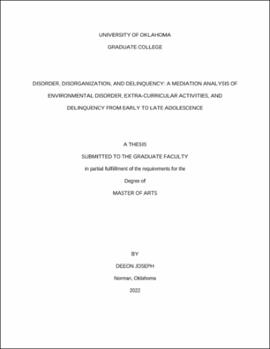| dc.description.abstract | According to the literature, youth violence, neighborhood crime rates, and early delinquency have been associated with vacant or abandoned housing, and adverse environmental and urban conditions (Jackson, Newsome, and Lynch 2017; Limbos and Casteel 2008; Yonas et al. 2007). Additionally, people of color are more likely to live in areas of inadequate housing and poor environmental conditions due to historical racism in housing policies, employment opportunities, and access to vital resources in a neighborhood context (de Leon and Schilling 2017; Sampson, Wilson, and Katz 2018). Literature surrounding Social Disorganization and Broken Windows theory note that physical and social disorder erode the community controls that bind social cohesion, ties, and control in communities creating a pretext for social disorganization. However, research is scant when examining the impact of objective physical disorder on late adolescent delinquency and how informal social control, such as extra-curricular activities, mediates this relationship.
I use data from the Fragile Families and Child Wellbeing Study (FFCWS), which is an active, panel survey that is administered to a nationally representative sample of 4898 families with interviews conducted between 1998 and 2017 comprised of six waves (Reichman et al. 2001). Objective measures of disorder are constructed from the variables available in this dataset to examine disorder’s impact on delinquency in late adolescence. I find that objective sources of physical disorder did not significantly affect an adolescent’s delinquency. However, participation in extra-curricular activities as a form of informal social control partially mediates this relationship. These findings illuminate several paths for policy implications and considerations going forward. | en_US |

